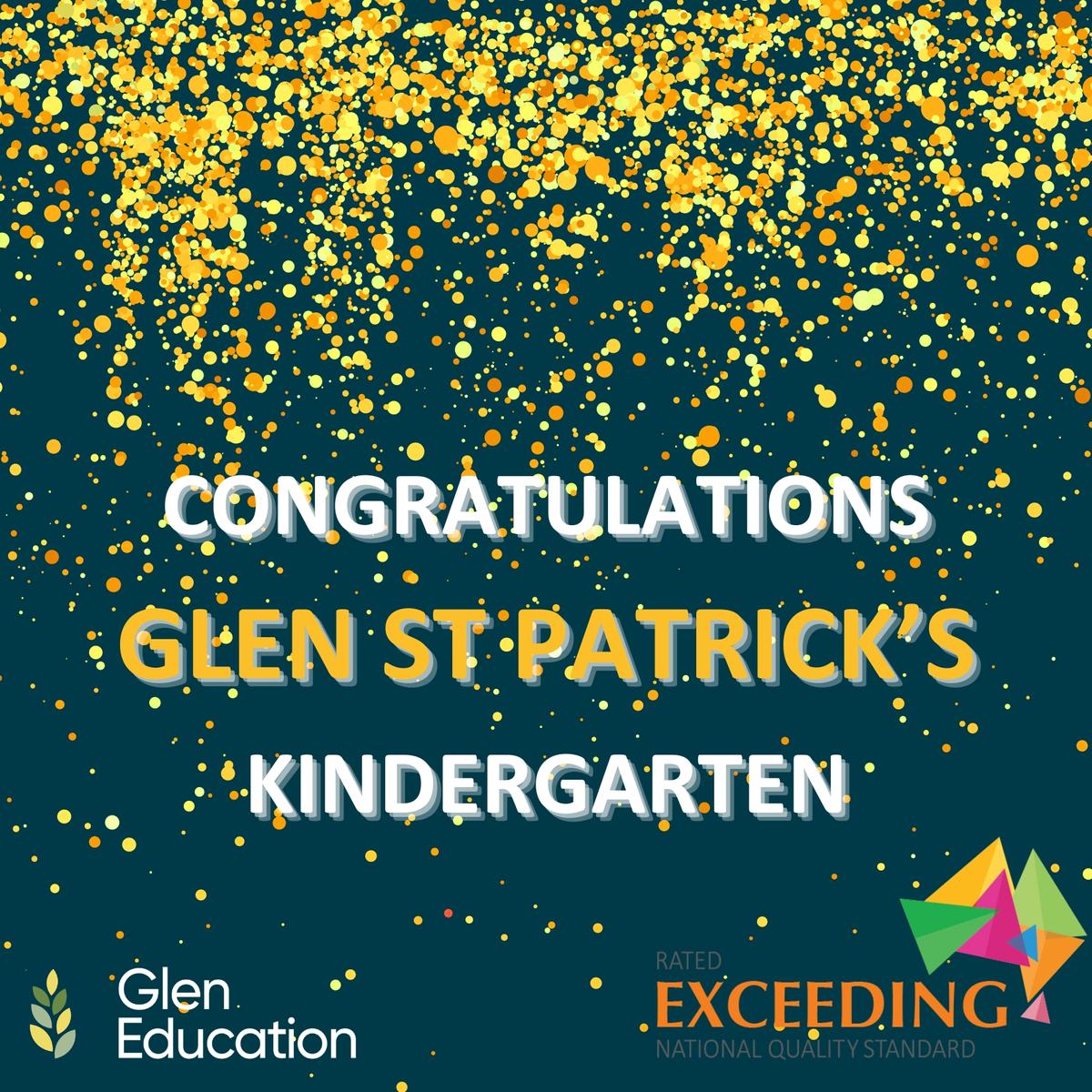Glen St Patrick's Kindergarten - Exceeding the National Quality Standards

Glen St Patrick's Kindergarten receives an EXCEEDING result for high-quality education and care.
Congratulations and thank-you to everyone at Glen Education that has worked hard to achieve this fantastic result – educators, leaders/managers, children, and families.
Here are a few highlights from the report to be proud of:
Quality Area 1 – Educational program and practice: Educators demonstrated intentionality in their decisions and actions with most educators observed engaged in play with children and at times using modelling, speculating and open-ended questioning to extend children’s thinking and learning. An educator was observed with a group of children who were hypothesising what would be behind the doors of a locking puzzle, the educator prompted the children to consider what was behind each door and provided them with positive encouragement and praise upon discovering the answer. Educators utilised projects to further children’s exploration and learning such as through an inquiry into bees and their interrelationship with people. During the visit children were observed using open ended craft materials to create their own bees with educators asking the children to describe their creations. Children’s agency was promoted through an environment that encouraged children to make choices about the direction of their play. Children had access to a range of resources, accessible shelving and inviting play spaces that encouraged imaginative and creative exploration through play. This was documented through displays in the room of children’s exploration of designing and making flags during a focus on the Olympic games.
Quality Area 2 – Children’s health and safety:
Each child’s health, wellbeing and physical activity was consistently supported and promoted through the educational program, with routines such as mealtimes used to engage children in conversations regarding healthy eating and utilising a community fruit sharing bowl to encourage children to try an array of different fruits. Opportunities for children to continually challenge their physical development through challenging physical activities were embedded within the program with educators purposefully considering physical play experiences for children.
Quality Area 3 – Physical environment: The service demonstrated an embedded approach to supporting sustainable practices and providing opportunities for children to consider what it meant to be environmentally responsible. Throughout the service children were observed exploring an array of natural, repurposed and open-ended resources. Throughout the educational program children were encouraged to consider the interconnecting relationships between people, plants, insects and animals. Environmental sustainability was further reinforced through the provision of established gardens and intentional teaching of the 7 R’s of sustainability. Educators were attuned to the needs of children and confidently organised and adapted environments and resources to provide a consistently inclusive and flexible play-based learning environment for all children. Children were observed engaging with a variety of open-ended materials available to them in collaborative play experiences exploring and challenging themselves through play. Throughout the learning environment children’s exploration and learning was documented through visual displays and photos providing further opportunities for children to revisit past learning.
Quality Area 4 – Staffing arrangements
A positive service atmosphere was evident through the respectful and responsive interactions between educators and with the management team. Educators actively supported each other engaging in ongoing communication both written and verbally to demonstrate practices that consistently aligned with the service philosophy of maintaining a culture of professional inquiry and reflective practice. Educators spoke about each other acknowledging and valuing the strengths and contributions of each team member. Professional discussions were facilitated through team meetings and reflective provocations that supported the ongoing self-assessment and quality improvement process.
Quality Area 5 – Relationships with children:
Educators’ interactions with children were warm, respectful and positive. Children were observed arriving at the service seeking out their educators to greet them demonstrating a sense of confidence within their environment and relationships. Some children were observed asking educators for assistance and educators were generally responsive to these requests which at times resulted in educators engaging in play-based experiences with children. Educators role modelled interactions that demonstrated consideration for the dignity and rights of children. Throughout the learning environment children were able to access a range of books and resources that challenged bias and fostered the notions of diversity and respect. When children arrived at the service and displayed challenges with separating from family members educators responded by providing reassurance at the child’s level and offering comfort until the child acknowledged that they were ready to engage in the program.
Quality Area 6 – Collaborative partnerships with families and communities: Children’s transitions were positively supported through ongoing collaboration with families, educators, and the co-located school. Children were provided with regular opportunities to form early connections with their school community through engagement with the schoolteachers and facilities in addition to a buddy program. The service demonstrated a commitment to ensuring the children developed a sense of belonging and were focussed on ensuring all children were supported to experience success. This approach was supported by the approved provider’s education and inclusion support team alongside children’s families and allied health supports in the development of personalised learning and inclusion support plans fostering a collaborative and consistent approach to supporting children within the service.
Quality Area 7 – Governance and leadership
Established governance and leadership arrangements had contributed to the development and promotion of a positive organisational culture where each staff member was a respected and valued member of the organisation and service team. Educators were supported to challenge their professional thinking and development through a lively culture of professional inquiry that was supported by the educational and pedagogy leaders. Regular provocations for reflective thinking were provided to the team to continually support a focus on ongoing quality improvement. Which was further supported by a robust self-assessment and quality improvement planning processes were that documented goals and actions towards achieving goals driving continuous improvement and enhancing outcomes for children and families.
CONGRATULATIONS!


